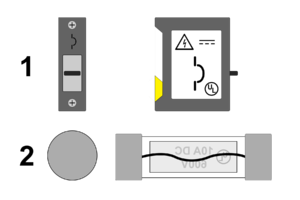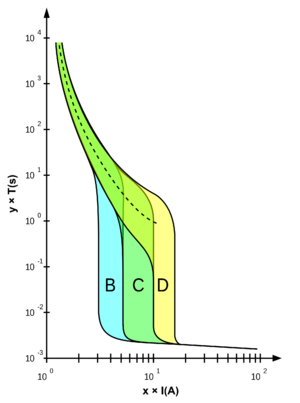Overcurrent protection device
All components of an electrical system have a maximum amount of current that they are rated to continuous handle, if this rating is exceeded excess heat will be generated which can result in a fire. Overcurrent protection devices (OCPDs) are used to automatically disconnect a circuit if a certain current is reached for a certain period of time. The size of the required overcurrent protection device is determined by the maximum amount of current that a circuit is anticipated to carry and the ampacity of the circuit wiring. The OCPD must be smaller than the rated ampacity of the wire. The most common types of overcurrent protection device that are used in electrical systems are fuses and breakers.
Contents
Characteristics
There are innumerable different OCPDs in the market with each one designed to fit a specific purpose. Many OCPDs are similar in appearance, therefore it is very important to revise the fine print on the side of any OCPD being considered to make sure that it is appropriate for the conditions of use.
Current type
OCPDs may be designed to work with AC, DC or both types of current. If a breaker is rated for both AC and DC, it is likely that the DC voltage rating will be lower as DC circuits are more difficult to interrupt.
Current
OCPDs will be rated for a specific continous current rating.
Standard international OCPD sizes: 1 A, 2 A, 4 A, 6 A, 10 A, 13 A, 16 A, 20 A, 25 A, 32 A, 40 A, 50 A, 63 A, 80 A, 100 A and 125 A.
Standard US OCPD sizes per US NEC: 15, 20,25, 30, 35, 40, 45, 50, 60, 70, 80, 90, 100, 110, 125, 150, 175, 200, 225, 250,300, 350, 400, 450, 500, 600, 700, 800, 1000, 1200, 1600, 2000, 2500, 3000,4000 5000, and 6000 amps. Additional standard fuse sizes are 1, 3, 6, 10, and 601 amps.
Trip curve
OCPDs will have a trip curve which specifies how long the device can sustain current above its continuous duty rating. This is desirable because in electrical systems there are often surge loads that require additional current for a very brief period of time when starting. If an OCPD does not have a slight time delay, it will trip every time a surge load is connected. For all typical circuits in an offgrid PV system, an OCPD with a time delay is recommended.
Maximum voltage
AC and DC breakers will be rated for the maximum circuit voltage that they are intended to work with. It can be difficult to find OCPDs rated to work with DC at higher voltages.
Ampere interrupting capacity rating
Ampere interrupting capacity (AIC) rating is the OCPDs ability to withstand current and still open (shut down) a circuit. This rating is typically hundreds of times the current rating of the breaker with a typical 15A household breaker having an AIC rating of 10,0000A. AIC ratings are typically not relevant in the case of offgrid PV systems.
Mounting type
- There are many different types of fuse holders and corresponding fuses. They must be designed to work together.
- Breakers will be designed to be mounted in a specific type of distribution panel or on a DIN rail.
Projected life
- Fuses only work once and need to be replaced after tripping. For offgrid applications breakers are always preferrable for this reason as acquiring replacement fuses in remote locations can be difficult.
- Breakers can typically withstand a minimum of hundreds of faults. If a breaker fails, it will typically fail open (circuit disconnected).
Maintenance
There is no maintenance to be done in either case, other than to make sure that the connections to the OCPD remain tight over time.
Recyclability
Standard breakers and fuses typically do not contain anything hazardous, but should be recycled as E-waste as traditional waste disposal streams cannot process them.

